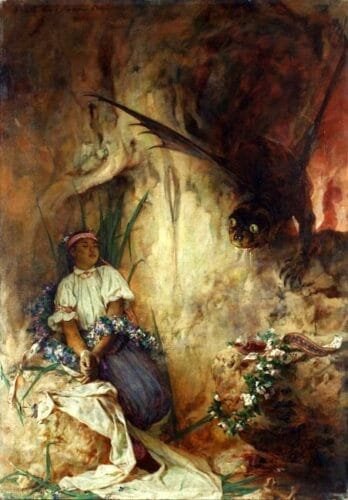Inspiring A Writer—The Mordiford Dragon

When a myth comes along and hands you your heroine, who am I to argue? Meet the Mordiford Dragon.
Most of the time when one is slogging through the research process in hopes of getting the right information for a story, one ends up doing some head thumping. Very rarely—all right, almost never—does one just happen into a magical piece of information that totally makes a story go from pretty good, to just plain “oh-my-gosh-this-is-freaking-awesome!” One of those moments came when I discovered the Mordiford Dragon, one of the backbone myths for Jane Austen’s Dragons.
Until that point, nearly all the dragon myths I’d read fell into the category of “dragon terrorizes town, man kills dragon” variety. But this one was totally different, if for no other reason, a woman and a dragon were at the forefront of the story. That alone riveted my attention, but wait, my friends, it gets better! In young Maud of Mordiford, I found the inspiration for Elizabeth Bennet, a woman whose sympathy for and understanding of dragonkind goes far and away beyond anything England has ever known.
The story of Maud and the Mordiford dragon (a wyvern actually, not the more typical ‘worm’—hmm, that doesn’t remind you of anything, does it?) is set in the Herefordshire village of Mordiford. Young Maud is terribly lonely and misunderstood by her parents. She desperately wants a pet, but her parents do not agree. So she spends a lot of time out wandering in the woods alone.

One day, Maud finds a green baby wyvern while on her morning walk. She takes the baby back to her home as a pet and feeds it milk, comforting it by stoking its claws and cuddling it. (Cuddling a dragon, not killing it! Yes, this had to be only the myth around featuring such a thing! Yeah, writers really do get excited by pretty weird things. But I digress…)
As the creature grows older, it starts dining on the Mordiford villagers, but refuses to injure his friend Maud. Despite her best efforts, she is unable to convince the creature to restrain himself. Not surprisingly, the villagers insist this is intolerable and find a nobleman (or condemned convict, depending on the version of the tale) to dispatch the beast.
Maud was described as ‘insane with rage’ over the death of her wyvern. A painting of the creature hung in the village church until 1811 when the vicar ordered it destroyed as a ‘sign of the devil’.
So many inspirations in this tale! Herefordshire/Hertfordshire, Mordiford/Meryton, ok, not the same, but it did make me do a double take for sure. A girl who is misunderstood by her parents and loved a baby dragon; who rescues dragons and cuddles with them; a grumpy wyvern that others cannot seem to get along with. Certainly such a woman would fit into a world where dragons and men lived together under the Pendragon Accords, and might even be a force to be reckoned with there. What better inspiration from which to draw Elizabeth Bennet?
It isn’t difficult to imagine a woman who loves dragons growing up to be instrumental in keeping the peace between humans and dragons, is it? So that’s exactly what I did!

&^$&* Vicar.
OH Dear…. I just recorded my favorite scene yet in 7 books. They just keep getting better.
Can’t wait to read this book
Yes! Yes! YES! I love Elizabeth and her affinity for dragons. That has always amazed me how she innately knows dragons and they know and respect her. Yep, what great research you found there.
What a fantastic find! Even the date of the painting’s destruction has a connection to Pride and Prejudice, at least in my mind (I always think of the story as starting in 1811). I love it when history reminds us how complex humanity is. Though there are many “dragon terrorizes town, man kills dragon” stories, your find is a reminder that there are also other stories to be told. Thanks for your storytelling and research, Maria Grace!
Thanks so much Christina! I just love finding these tidbits!
I have loved these stories. Interesting article here! Hard to imagine an actual painting as if dragons are real.
“A painting of the creature hung in the village church until 1811 when the vicar ordered it destroyed as a ‘sign of the devil’.” Can’t imagine a man of God or any church hanging that.